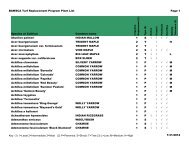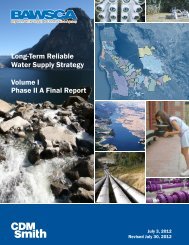SFPUC Wholesale Customer Water Demand Projections ... - BAWSCA
SFPUC Wholesale Customer Water Demand Projections ... - BAWSCA
SFPUC Wholesale Customer Water Demand Projections ... - BAWSCA
Create successful ePaper yourself
Turn your PDF publications into a flip-book with our unique Google optimized e-Paper software.
SECTIONTHREE<br />
Establishing Base - Year Conditions<br />
Table 3-5<br />
Dwelling Unit by Building Type from Census 2000<br />
Assumed Number of Dwelling Units per<br />
Building Type<br />
Building/Complex<br />
Single-Family<br />
1-detached 1<br />
1-attached 1<br />
Multifamily<br />
2-units 2.0<br />
3-4 units 3.5<br />
5 to 9 units 7.0<br />
10-19 units 15<br />
20 or more units 50<br />
Mobile homes 50<br />
Source: Census 2000 (U.S. Census Bureau 2002)<br />
The number of dwelling units provided by the census was divided by the assumed number of<br />
dwelling units per building to determine the estimated number of buildings (or housing<br />
complexes).<br />
Step 2: Apportioning Dwelling Units to Residential Billing Categories<br />
The total number of “Single-Family 1-detached” buildings was compared with the number of<br />
Single-Family Residential accounts in 2000 (obtained from billing records) to determine if the<br />
“Single-Family 1-attached” buildings were represented by billing data. If not all the “Single-<br />
Family 1-detached” buildings were represented in the Single-Family Residential accounts, then it<br />
was assumed they were grouped with the Multi-Family Residential accounts. This grouping can<br />
occur depending on how a wholesale customer categorizes townhouses, condos, etc. Some<br />
agencies categorize these types of residences as multifamily while others may categorize them as<br />
single-family.<br />
The assumptions for number of dwelling units per building (or residential complex) were<br />
adjusted to obtain a reasonable match between the number of buildings and the number of Multi-<br />
Family Residential accounts in 2000 (billing records). The final number of multi-family dwelling<br />
units was divided by the number of Multi-Family Residential accounts to obtain an average<br />
number of dwelling units per account for each wholesale customer. Each value was assumed to<br />
remain constant from 2000 to 2001 (base year).<br />
Determining Average Household Sizes<br />
Average household sizes are important parameters in developing an end-use model because they<br />
provide a link between the customer-billing data (such as the number of Single-Family accounts)<br />
and the end-use data (such as the residents use water in the accounts). Therefore, a complex<br />
iterative process was used to ensure that the household sizes not only fit known demographic<br />
data, but also produce reasonable water use results. The following steps describe the process<br />
used in determining the average household sizes for single-family and multi-family residences:<br />
3-15







